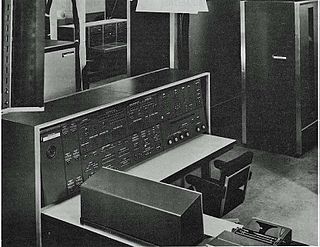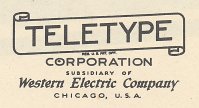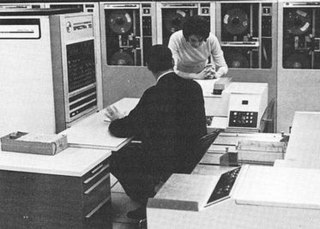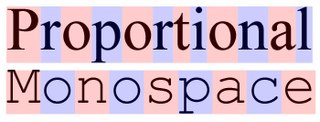
A teleprinter is an electromechanical device that can be used to send and receive typed messages through various communications channels, in both point-to-point and point-to-multipoint configurations. Initially they were used in telegraphy, which developed in the late 1830s and 1840s as the first use of electrical engineering. The machines were adapted to provide a user interface to early mainframe computers and minicomputers, sending typed data to the computer and printing the response. Some models could also be used to create punched tape for data storage and to read back such tape for local printing or transmission.
John William Mauchly was an American physicist who, along with J. Presper Eckert, designed ENIAC, the first general purpose electronic digital computer, as well as EDVAC, BINAC and UNIVAC I, the first commercial computer made in the United States.

The UNIVAC I was the first commercial computer produced in the United States. It was designed principally by J. Presper Eckert and John Mauchly, the inventors of the ENIAC. Design work was started by their company, Eckert–Mauchly Computer Corporation (EMCC), and was completed after the company had been acquired by Remington Rand. In the years before successor models of the UNIVAC I appeared, the machine was simply known as "the UNIVAC".
UNIVAC is a line of electronic digital stored-program computers starting with the products of the Eckert–Mauchly Computer Corporation. Later the name was applied to a division of the Remington Rand company and successor organizations.

The UNIVAC 1100/2200 series is a series of compatible 36-bit computer systems, beginning with the UNIVAC 1107 in 1962, initially made by Sperry Rand. The series continues to be supported today by Unisys Corporation as the ClearPath Dorado Series. The solid-state 1107 model number was in the same sequence as the earlier vacuum-tube computers, but the early computers were not compatible with the solid-state successors.

The UNIVAC 1105 was a follow-on computer to the UNIVAC 1103A introduced by Sperry Rand in September 1958. The UNIVAC 1105 used 21 types of vacuum tubes, 11 types of diodes, 10 types of transistors, and three core types.
The UNIVAC Solid State was a magnetic drum-based solid-state computer announced by Sperry Rand in December 1958 as a response to the IBM 650. It was one of the first computers to be (nearly) entirely solid-state, using 700 transistors, and 3000 magnetic amplifiers (FERRACTOR) for primary logic, and 20 vacuum tubes largely for power control. It came in two versions, the Solid State 80 and the Solid State 90. In addition to the "80/90" designation, there were two variants of the Solid State – the SS I 80/90 and the SS II 80/90. The SS II series included two enhancements – the addition of 1,280 words of core memory and support for magnetic tape drives. The SS I had only the standard 5,000-word drum memory described in this article and no tape drives.

The UNIVAC LARC, short for the Livermore Advanced Research Computer, is a mainframe computer designed to a requirement published by Edward Teller in order to run hydrodynamic simulations for nuclear weapon design. It was one of the earliest supercomputers.
The UNISERVO tape drive was the primary I/O device on the UNIVAC I computer. Its place in history is assured as it was the first tape drive for a commercially sold computer.

The UNIVAC II was an improvement to the UNIVAC I that UNIVAC first delivered in 1958. The improvements included core memory of 2,000 to 10,000 words, UNISERVO II tape drives which could use either the old UNIVAC I metal tapes or the new PET tapes, and some of the circuits were transistorized although it was still a vacuum tube computer. It was fully compatible with existing UNIVAC I programs for both code and data. It weighed about 16,000 pounds.

Uniscope was a class of computer terminals made by Sperry Rand Corporation, Univac Division, and successors since 1964 that were normally used to communicate with Univac mainframes. As such, it was the successor to various models of Teletype. Due to the text color on the original models, these terminals are informally known as green screen terminals.
The Eckert–Mauchly Computer Corporation (EMCC) was founded by J. Presper Eckert and John Mauchly. It was incorporated on December 22, 1947. After building the ENIAC at the University of Pennsylvania, Eckert and Mauchly formed EMCC to build new computer designs for commercial and military applications. The company was initially called the Electronic Control Company, changing its name to Eckert–Mauchly Computer Corporation when it was incorporated. In 1950, the company was sold to Remington Rand, which later merged with Sperry Corporation to become Sperry Rand, and survives today as Unisys.

The UNIVAC 1050 was a variable word-length decimal and binary computer.

The Teletype Corporation, a part of American Telephone and Telegraph Company's Western Electric manufacturing arm since 1930, came into being in 1928 when the Morkrum-Kleinschmidt Company changed its name to the name of its trademark equipment. Teletype Corporation, of Skokie, Illinois, was responsible for the research, development and manufacture of data and record communications equipment, but it is primarily remembered for the manufacture of electromechanical teleprinters.
George R. Cogar was the head of the UNIVAC 1004 electronic design team code named the "bumblebee project", and later the "barn project", and co-founder of Mohawk Data Sciences Corporation, a Herkimer, N.Y.-based multimillion-dollar business built largely on his invention of the Data Recorder magnetic tape encoder, which was introduced in 1965 and eliminated the need for keypunches and punched cards by direct encoding on tape. He also founded the Cogar Corporation, where he built an intelligent terminal—an early forerunner of the modern personal computer—which he called the Cogar System 4 or Cogar 4. The Cogar 4 became the Singer 1500 after Singer Business Machines acquired Cogar Corporation. In 1976 International Computers Limited (ICL) acquired Singer Business Machines, changing the name of the computer to the ICL 1500.

The RCA Spectra 70 was a line of electronic data processing (EDP) equipment manufactured by the Radio Corporation of America’s computer division beginning in April 1965. The Spectra 70 line included several CPU models, various configurations of core memory, mass-storage devices, terminal equipment, and a variety of specialized interface equipment.
VS/9 is a discontinued computer operating system available for the UNIVAC Series 90 mainframes during the late 1960s through 1980s. The 90/60 and 90/70 were repackaged Univac 9700 computers. After the RCA acquisition by Sperry, it was determined that the RCA TSOS operating system was far more advanced than the Univac counterpart, so the company opted to merge the Univac hardware with the RCA software and introduced the 90/70. The 90/60 was introduced shortly thereafter as a slower, less expensive 90/70. It was not until the introduction of the 90/80 that VS/9 finally had a hardware platform optimized to take full advantage of its capability to allow both interactive and batch operations on the same computer.

The UNIVAC 9000 series was introduced by Sperry Rand in the mid-1960s to compete with the low end of the IBM System/360 series. The 9200 and 9300 implemented the same restricted 16-bit subset of the System/360 instruction set as the IBM 360/20, while the UNIVAC 9400 implemented a subset of the full 32-bit System/360 instruction set. The 9400 was roughly equivalent to the IBM 360/30.












